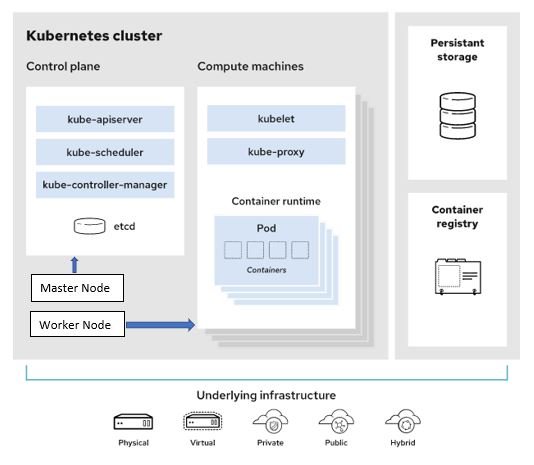Dear Friends in this session we discussed Introduction about Kubernetes and its features. So let’s start and see first off all Introduction about Kubernetes, and then we will see Kubernetes features.
Introduction about Kubernetes
Kubernetes is an open-source coordination PC program that gives an API to control how and where those holders will run. Its endowments you to run your Docker holders, remaining tasks at hand and makes a refinement you to deal with some of the working complexities when moving to scale various holders, sent over various servers.
For more details about kubernetes you can
Kubernetes allows you to organize a bunch of virtual machines and timetable compartments to run on those virtual machines dependent on their accessible process assets and the asset prerequisites of every holder. Holders are assembled into cases, the fundamental operational unit for Kubernetes. These holders and cases can be scaled to your ideal state and you’re ready to deal with their lifecycle to keep your applications ready for action.
Kubernetes Cluster Architecture

Yet, what does Kubernetes have to do with IoT? For what reason would it be advisable for you to think about a foundation apparatus?
Things being what they are, the advantages of Kubernetes—abstracting endlessly cloud foundation and dealing with a microservice design—likewise reduces the one of a kind issues IoT arrangements present. By normalizing an interface for holders to run with minimal overhead requiring little to no effort, Kubernetes can streamline the operational weights of sending on the edge or in the cloud.
This eBook begins with a diagram of Kubernetes and strolls through a portion of the exercises that the designers at Leverege have picked up running Kubernetes underway on the absolute biggest IoT arrangements in North America. On the off chance that you are thinking about a change to utilizing Kubernetes or hoping to turn up another foundation practice, read on to assess the advantages of Kubernetes for your IoT arrangement.
Features of Kubernetes
There are the basic highlights of Kubernetes: –
- Computerized Scheduling
- Self-Healing Capabilities
- Computerized rollouts and rollback
- Flat Scaling and Load Balancing
- Offers condition consistency for advancement, testing, and creation
- A framework is approximately coupled to every segment can go about as a different unit
- Gives a higher thickness of asset use
- Offers venture prepared highlights
- Application-driven administration
- Auto-adaptable foundation
- You can make an unsurprising framework
Kubernetes Basics
Here, are some important Basics of Kubernetes
Cluster: – It may be a collection of has (servers) that makes a difference you to total their accessible assets. That incorporates smash, CPU, RAM, disk, and their gadgets into a usable pool.
Master: – The ace might be an assortment of parts that make up the control leading body of Kubernetes. These segments are used for all cluster decisions. It incorporates both planning and reacting to the cluster occasions.
Node: – It might be a solitary have which is competent of running on a physical or virtual machine. A node has to run Kube-intermediary, minikube, and kubelet which are considered as an element of the cluster.
Namespace: – It might be a legitimate cluster or condition. It could be an extensively used system which is used for perusing get to or dividing a cluster.
You can click on below link to see step by step kubernetes cluster installation on CentOS 7 VM
Conclusion
The container encourages an association to perform upkeep and update without intruding on administrations. Kubernetes is a case of a container the board framework created in the Google stage. The greatest preferred position of utilizing Kubernetes is that it can run on-premise. OpenStack, open mists Google, Azure, AWS, and so forth.
Kubernetes offers robotized Scheduling and Self-Healing Capabilities. Group, ace, hub, and namespace are significant fundamental of Kubernetes.
Ace hub and work hub are significant parts of Kubernetes engineering. Replication Controllers, Replication sets, Deployments, Stateful Sets, Daemon Sets are other significant terms utilized in Kubernetes. Docker swarm doesn’t permit auto-scaling while Kubernetes permits auto-scaling. The greatest disadvantage of Kubernetes is that it’s dashboard not exceptionally helpful and powerful.
Hmm it looks like your website ate my first comment (it was extremely long) so I guess I’ll just sum it up what I submitted and say, I’m thoroughly enjoying your blog. I as well am an aspiring blog writer but I’m still new to the whole thing. Do you have any tips and hints for inexperienced blog writers? I’d genuinely appreciate it.
Thank you a lot for providing individuals with such a breathtaking opportunity to read critical reviews from this site. It is always so pleasant and as well , stuffed with a great time for me and my office mates to search your website no less than three times per week to see the fresh issues you have. And indeed, I’m also always motivated with all the gorgeous concepts you serve. Selected 3 ideas on this page are definitely the most suitable I have had.
Thanks for another informative blog. Where else could I get that type of info written in such an ideal way? I have a project that I’m just now working on, and I have been on the look out for such information.